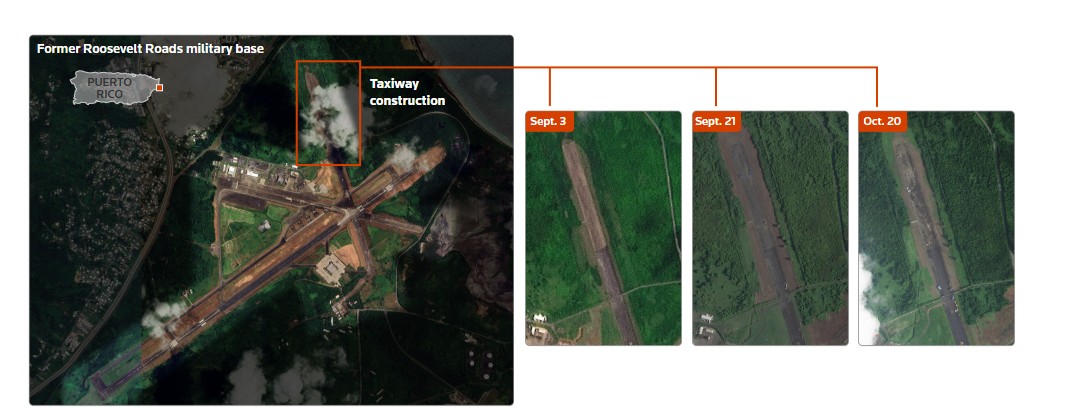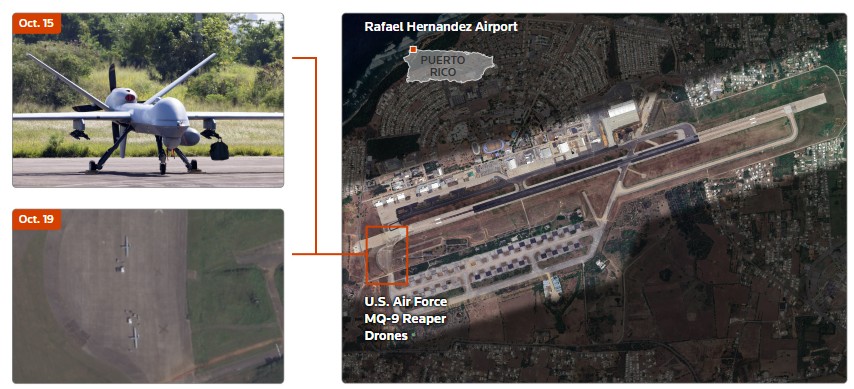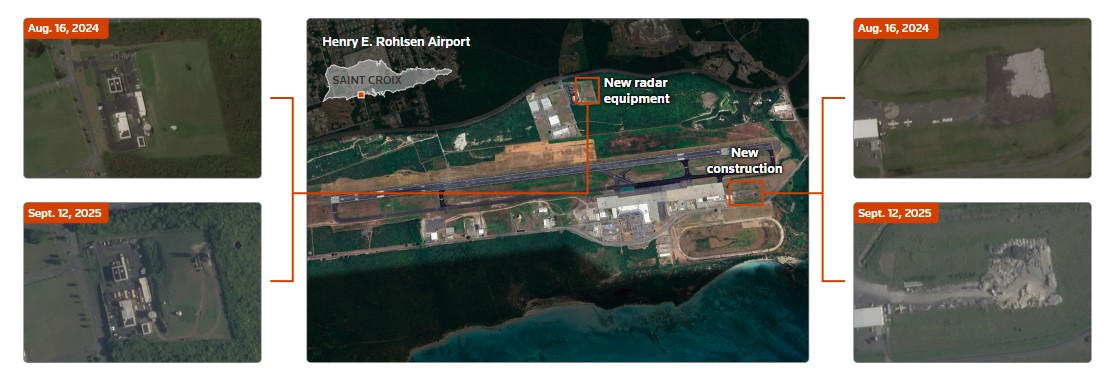
The U.S. military is modernizing a long-abandoned Cold War-era naval base in the Caribbean, according to a Reuters visual investigation. This suggests preparations for sustained operations that could support potential actions inside Venezuela.
By reuters.com
Work at the former Roosevelt Roads naval base in Puerto Rico —closed by the Navy more than 20 years ago— began on September 17, when crews started cleaning and repaving the taxiways leading to the runway, according to photographs taken by Reuters.
Until the Navy withdrew from the facility in 2004, Roosevelt Roads was one of the largest U.S. naval bases in the world. The base occupies a strategic location and offers ample space for equipment storage, according to a U.S. official.
In addition to improvements to landing and takeoff capabilities at Roosevelt Roads, the United States is building facilities at civilian airports in Puerto Rico and St. Croix, in the U.S. Virgin Islands.
The two US territories are located about 800 kilometers from Venezuela.
Reuters spoke with three U.S. military officials and three maritime experts, who said that new construction in Puerto Rico and the Virgin Islands points to preparations that could allow the U.S. military to conduct operations inside Venezuela. Venezuelan President Nicolás Maduro has repeatedly alleged that the United States is seeking to overthrow him.
“I think all of this is designed to intimidate the Maduro regime and the generals surrounding him, in the hope of creating divisions,” Christopher Hernandez-Roy, a senior fellow at the Center for Strategic and International Studies (CSIS) in Washington, told Reuters.
To monitor U.S. military activity in the region over the past two months, Reuters photographed U.S. military bases and reviewed satellite imagery, ship and flight tracking data, and social media posts. The news agency also tracked the movements of U.S. military vessels through on-the-ground reporting and publicly available photographs and videos.
The military deployment in the region is the largest unrelated to humanitarian aid since 1994, when the United States sent two aircraft carriers and more than 20,000 troops to Haiti to participate in “Operation Support for Democracy”.
Since the beginning of September, the United States has carried out at least 14 attacks against suspected drug-trafficking vessels in the Caribbean and the Pacific, resulting in 61 deaths.
The attacks on suspected drug-trafficking vessels have increased tensions with Venezuela and Colombia and highlighted a region of the world that has received limited resources from the U.S. military in recent years.
When asked about the military expansion in the region, the White House stated that President Donald Trump had promised during his election campaign to combat the region's drug cartels.
"He has taken unprecedented steps to stop the scourge of narcoterrorism that has caused the needless deaths of innocent Americans," White House spokeswoman Anna Kelly said in a statement to Reuters.
The US military deployment in the Caribbean began in August with the arrival of warships, a nuclear submarine, fighter jets and reconnaissance aircraft.
The Ford carrier strike group, with approximately 10,000 personnel and dozens of aircraft and weapons systems, is heading from the Adriatic Sea. One of the Ford's destroyers sailed from Gibraltar on October 29, according to satellite imagery and ship-tracking data.
The Pentagon did not respond to a request for comment following Reuters' findings. The governor of Puerto Rico also did not respond to a request for comment.
Development of bases in the Caribbean
Some of the most significant infrastructure improvements are taking place at the former Roosevelt Roads base, where taxiways are being modernized with upgrades that analysts say will allow their use by both fighter and cargo aircraft.
Mark Cancian, a retired U.S. Marine Corps colonel and senior advisor to CSIS, said these changes are in line with preparations for an increase in military aircraft landings and takeoffs.

In addition to the taxiway renovation work, Reuters observed the installation of portable air traffic support equipment and other mobile safety equipment.
Satellite images taken on October 29 show 20 new tents southeast of the runway, near an abandoned aircraft hangar.

Hernández-Roy, a researcher at CSIS, told Reuters that it was possible the U.S. military was simply patching potholes. But he added: “If their focus is now on the Western Hemisphere, it makes perfect sense that they would want to reopen what was once a huge naval base and ensure it can accommodate the variety of aircraft used by the U.S. military.”

Reuters also detected significant changes at Rafael Hernandez Airport, Puerto Rico's second busiest civilian airport.
By mid-October, the U.S. military had deployed communications equipment and a mobile air traffic control tower, which is commonly used to coordinate large numbers of aircraft in war zones or after disasters.
According to military experts, mobile air traffic control towers are used to coordinate a larger number of aircraft entering and leaving a region.

Satellite images show the construction of an ammunition depot at the airport, although experts consulted by Reuters indicated that it was unclear what type of weapons might be stored there.
That's very important, Cancian stated. They could be used in the short term in an operation against Venezuela. However, he acknowledged that the installation could also indicate long-term planning for operations against the cartels.
On the nearby island of Santa Cruz, satellite images taken in September and October also show construction activity at a civilian airport.
Images from Henry E. Rohlsen Airport show ongoing construction near the apron, where aircraft are parked and serviced. The apron upgrades would allow more U.S. military aircraft to park and refuel, U.S. officials told Reuters.

A video recorded by a local resident at Reuters' request shows a new radar system at the airport.
Albert Bryan Jr., governor of the U.S. Virgin Islands, stated through his office that while there is coordination with the U.S. military regarding troop deployments in the territory, his office does not have access to operational details or future planning for such operations.
"It believes that the regional presence of the U.S. military strengthens security and deters drug and arms trafficking through the territory," the statement said.
Hernández-Roy, from CSIS, indicated that the changes could be aimed at supporting the large number of U.S. military aircraft arriving in the region. The improvements could also help address deficiencies in radar surveillance capabilities, should drug traffickers choose to use aircraft instead of ships.
“The only deficiency in radar coverage, which poses a constant problem for intercepting drug trafficking flights, is over Haiti, and it’s like a big black hole,” Hernández-Roy added.
According to the State Department, Haiti is used as a transit point for trafficking cocaine and marijuana from South America to the United States.
The Haitian embassy did not immediately respond to a request for comment. A video recorded on the island by a local resident at Reuters' request shows a new radar system at Henry E. Rohlsen Airport in St. Croix, U.S. Virgin Islands, on October 30, 2025. Photo distributed by REUTERS.

